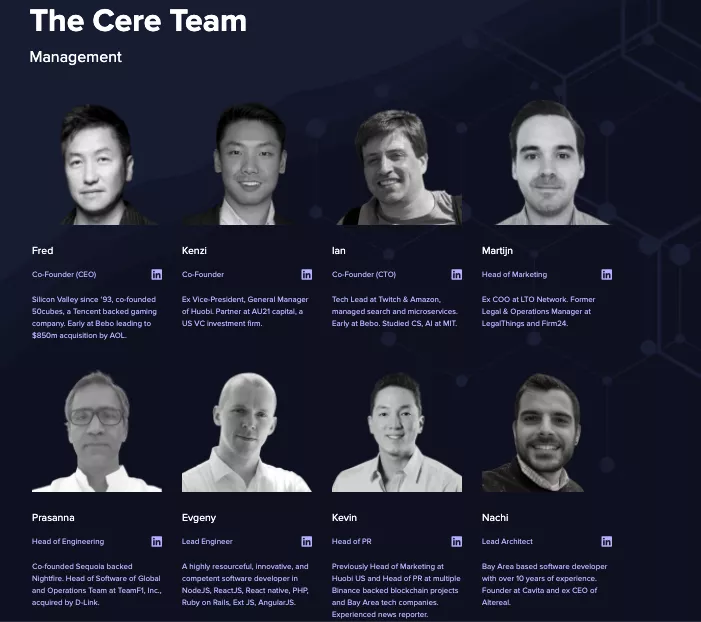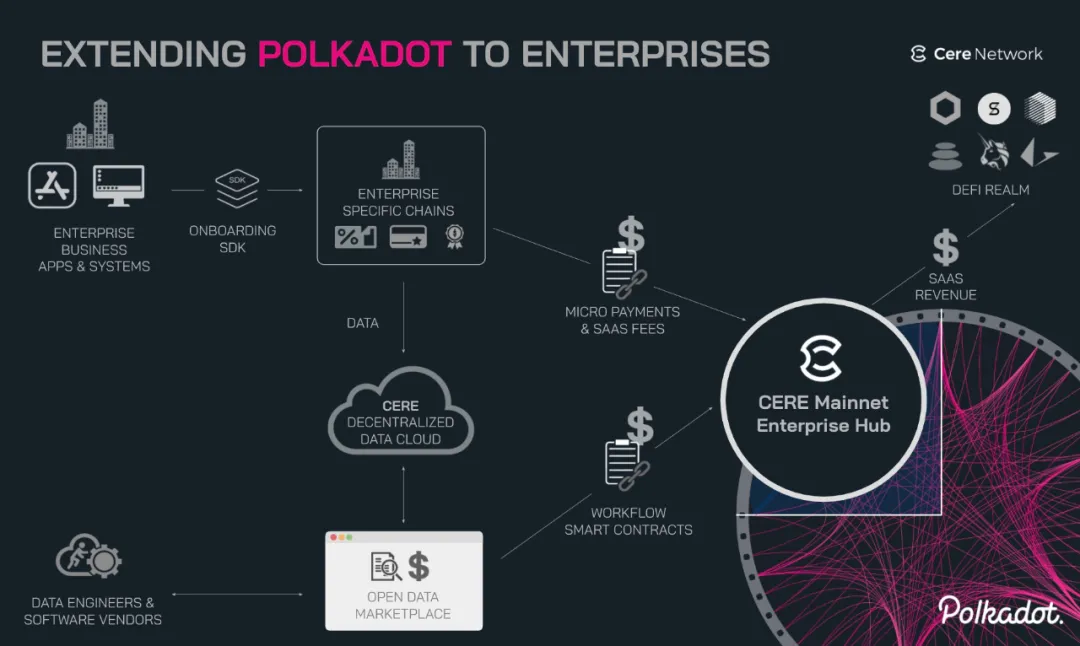What will happen when Polkadot data star Cere Network meets the veteran Silicon Valley compliance platform Republic? What kind of charm will the first public offering cooperation between two popular projects combine with hot spots such as "compliance, Polkadot, top institutions, and luxury investment background"?
In order to have a deeper understanding of Cere Network and Republic's public offering rules, on March 23, 2021, CryptoJ invited Martjin Broersma, Chief Marketing Officer of Cere Network, and Miraitowa, Republic Community Manager, to the CryptoJ community to hold a theme "Republic Public Offering Decentralization" AMA sharing by data market star Cere Network".
This is the first time that Cere Network met with you before the public offering. Martjin Broersma mainly conducted detailed and in-depth discussions on Cere Network's project features and positioning, core team, Polkadot ecological development, application scenarios, and token economic models. , Miraitowa also shared with us the precautions about the Republic public offering.
The following is the organization of the AMA text content, and the content has been deleted.

Cere's Vision for Cross-Chain Interoperability
When Martijn Broersma was asked about the Cere Network project introduction, features, key areas of focus, and mode of operation, he answered as follows:
Simply put, Cere is part of an alliance of projects like Polkadot and Cosmos, combining the vision of cross-chain interoperability between blockchain networks to achieve an inclusive, trusted, and infinitely scalable global enterprise-oriented Decentralized ecosystem.
Cere Network is the first decentralized data cloud platform that can optimize integrated service data and collaborative data. Although most blockchains are just distributed ledgers, Cere's blockchain network can provide turnkey (one-stop) ultra-customized solutions for enterprise data ecosystems.
first level title
Challenging industry giants: Cere focuses on modular and custom solutions
Martijn Broersma also shared with us why Cere chose the "data service, data cloud" track, what is the difference from Salesforce, Oracle, Microsoft and other large-scale projects we are familiar with, and how to break out of the topic.
Martijn Broersma points out that traditional CRM is outdated: expensive and difficult to integrate with today's intelligent (AI) and data-driven solutions. New data cloud solutions such as Snowflake can offer greater flexibility and faster integration, bringing recent real-time computing to highly dynamic and customizable datasets.
Therefore, Cere will replace these CRM/CDP spaces in the future, and eventually replace the traditional giants such as Salesforce, SAP, Adobe and Snowflake. But for now, Cere is not facing the SaaS challenge head-on, but is focusing on building more specific solutions for travel, travel and retail, so that Cere can be more focused and competitive.
In addition, the power of Cere alone cannot solve all problems, and other developers will be able to build more modular and customized solutions on the basis of Cere Network to build industry or specific applications.
The key to Cere's solution is to bring greater data agility and more data interoperability to the market, and Cere has an open approach compared to Snowflake's specific (solution). Also, Cere is more focused on consumer businesses which have more customizable solutions in special industries.
The story behind the core team
Recently, Cere announced the appointment of a number of board members, such as the appointment of the former COO of the software giant Salesforce, which further strengthened the strength of the team. Martijn Broersma also chatted with us about the background of Cere's core team and the stories of team members.
Martijn Broersma said that the Cere core team consists of Fred, Kenzi, Ian and himself.
Fred (Co-Founder & CEO) is the Co-Founder of 50cubes, a gaming platform company backed by Tencent that provides services from 1st party to 3rd party games to millions of users. He was also the lead developer of Bebo, an early social network that was acquired by AOL for $850 million. Previously, Fred also held key engineering and product-related positions at Silicon Valley startups in various fields including enterprise, media, and artificial intelligence.
Co-founder Kenzi served as the vice president and general manager of Huobi Global, where he was responsible for exchange operations, business development, marketing and customer services. In addition, he is also a partner of AU21 Capital, an American venture capital firm, which focuses on investing in blockchain applications and DeFi companies.
Cere's CTO, Ian, was a tech lead at Twitch and Amazon, and before that Ian also worked with Fred at Bebo, where Ian led the development of the social feed (personalized feed).
Martijn Broersma is Cere's CMO and has been working as Chief Operating Officer at Amsterdam-based blockchain company LTO Network for three years before coming to Cere. During his tenure, he played an important role in the development of LTO Network into the top ten most used blockchains in the world, achieving the highest blockchain adoption rate in the world.
Cere's Advisory Board members are as follows:
Brad Boa - Chairman of Lime
Rajani Ramanathan - Former Salesforce COO
Jochum Haakma - Chairman of China Europe Business Association

Perfect fit with Polkadot ecology
Cere received support from the Web3 Fund at the end of December last year. Compared with the bottom layer of Ethereum, why did Cere choose to join the Polkadot ecosystem? Martijn Broersma also answered questions about whether Cere will consider participating in the Polkadot parachain slot auction that continues to be hotly debated in the market.
Martijn Broersma said that Polkadot was chosen because its ambitions and aspirations fit perfectly with Cere, where data interoperability is crucial in providing enterprise partners with the technology needed for heavy transactions.
 To further strengthen the partnership, Cere Network received a grant from the Web3 Foundation to further develop a one-stop dedicated independent blockchain network that can be easily integrated by any enterprise.
To further strengthen the partnership, Cere Network received a grant from the Web3 Foundation to further develop a one-stop dedicated independent blockchain network that can be easily integrated by any enterprise.
first level title
Enterprise-level landing application
The concept of "decentralized data cloud platform" advocated by Cere seems to be more popular with enterprise customers. We also discussed topics such as the progress of its ecology and implementation, and whether there will be a possibility of large-scale implementation.
Martijn Broersma pointed out that Cere currently has 2 separate testnets, one for current live integration and the other for rapid development and testing.
The Cere decentralized data cloud works seamlessly with the two testnets and is already supporting other networks including Cere's planned mainnet.
Cere also has an enterprise secondary private network for connecting to the Cere testnet, which is currently open sourced on Github.
first level title
Cere Development Roadmap
Martijn Broersma also shared whether Cere will consider launching more use cases for ordinary users in the future, as well as the recent project development plan and roadmap.
Cere is currently serving several Fortune 1000 companies, and Cere will release its first use cases soon.
Over the next 12 months, Cere's roadmap looks like this:
Complete fundraising and initial listing in the first quarter of 2021 (private placement/public placement/LPD)
Recruit outstanding innovators and developers to further expand the team
Alpha mainnet will launch at the end of Q1 2021 to support upcoming enterprise integrations
Collaborate with other top Polkadot projects and the W3f team to thoroughly test, prepare mainnet and prepare for parachain operation
Complete three or more additional integrations with top brands to build successful case studies, accelerate content distribution and other growth
Reach $1M+ in revenue and 2M monthly active users
first level title
Value Capture for Cere Tokens: Proof of Stake and Network Governance
Finally, Martijn Broersma also shared with CryptoJ about the design of token value capture, the token economic model, how to motivate users to hold tokens for a long time, token application scenarios and other topics that users care about.
Martijn Broersma said above all that CERE is a utility token powering a transformational enterprise data framework. The CERE token powers the Cere open data marketplace and SaaS-DeFi ecosystem. In addition to playing a utility role, CERE tokens will also be used for proof-of-stake consensus and network governance.
Cere provides convenient exchange (B2B) for SaaS utilities and fees through tokenization and easy exchange (features), which will enable business-to-consumer payments, value transfers, and NFT applications (B2C) in the real world. Function.
As Cere said, Cere is currently attracting millions of users to use the network. All of these operations require tokens, which will provide investors with the benefit of increasing prices over time.
Republic public offering rules
After Martijn Broersma completed the wonderful answer, CryptoJ invited Miraitowa, the community manager of Republic.co, to come to us to answer questions about Cere Network's public offering on the Republic platform in detail
Miraitowa pointed out that the details of the public offering will be announced before the end of this month. Please pay attention to the announcements on the Republic website and the community. Once again, as a compliant public offering platform, Republic can participate without a whitelist.
For whether KYC is required? Can Chinese users participate in investment? Miraitowa has some questions about the planning of public offering projects recently, and Miraitowa answered as follows:
There is no doubt that as a compliant platform, Republic.co must be KYC. However, Republic's KYC is different from Coinlist. Under the US judicial system, Republic supports users from most countries to participate in public sales (including mainland China). Therefore, you can safely use your Chinese registered address and passport for KYC certification.
Regarding future plans, Republic is seeking to participate in some big projects, and it is not convenient to disclose more at present. Republic hopes that everyone can pay more attention to other projects of Republic, including start-up equity, real estate, games and other crowdfunding projects.
Finally, Republic also once again reminds everyone to pay attention to risks. Even though Republic has conducted the necessary background checks and risk control audits, Republic cannot guarantee that the information disclosed by the company must be true and trustworthy, nor can it guarantee that the company can achieve its goals according to the business plan, and cannot promise Investors can realize withdrawal or equity transfer.
About CryptoJ
About CryptoJ
CryptoJ is a community service solution provider, a new generation of blockchain investment, research and service institutions, and has established deep partnerships with leading media, developer communities, business elites and financial institutions in the encryption world. CryptoJ brings together a wide range of KOL network systems, professional industry information, in-depth research and analysis, high-quality communities, hot market project dynamics and other multi-faceted blockchain industry resources. Match differentiated services in the market in real time, provide analysis and customized services, form community alliances, cooperate with exchanges to promote, and build vertically segmented channels such as self-media services at home and abroad. CryptoJ will provide real marketing value to your project and build broad brand awareness in China and the world.